Human Biology Report: Homeostasis, Exercise, and Osmoregulation
VerifiedAdded on 2023/01/17
|15
|3918
|89
Report
AI Summary
This report provides a comprehensive overview of human biology, focusing on the maintenance of homeostasis within the human body. It explores the roles of the cardiovascular, neuroendocrine, and nervous systems in maintaining internal equilibrium, discussing the components and functions of blood, including red and white blood cells, platelets, and plasma, and how the heart circulates blood throughout the body. The report defines homeostasis and explains how the nervous and endocrine systems work together to regulate physiological parameters like body temperature, blood pressure, and blood glucose levels, including feedback mechanisms. It also delves into the effects of exercise on the body, specifically examining changes in ventilation rate and heart rate, and concludes with a discussion of osmoregulation, explaining how the nervous, endocrine, and urinary systems work together to maintain blood water potential during and after exercise. The report includes an introduction, discussion, conclusion, references, and an appendix to support the findings.
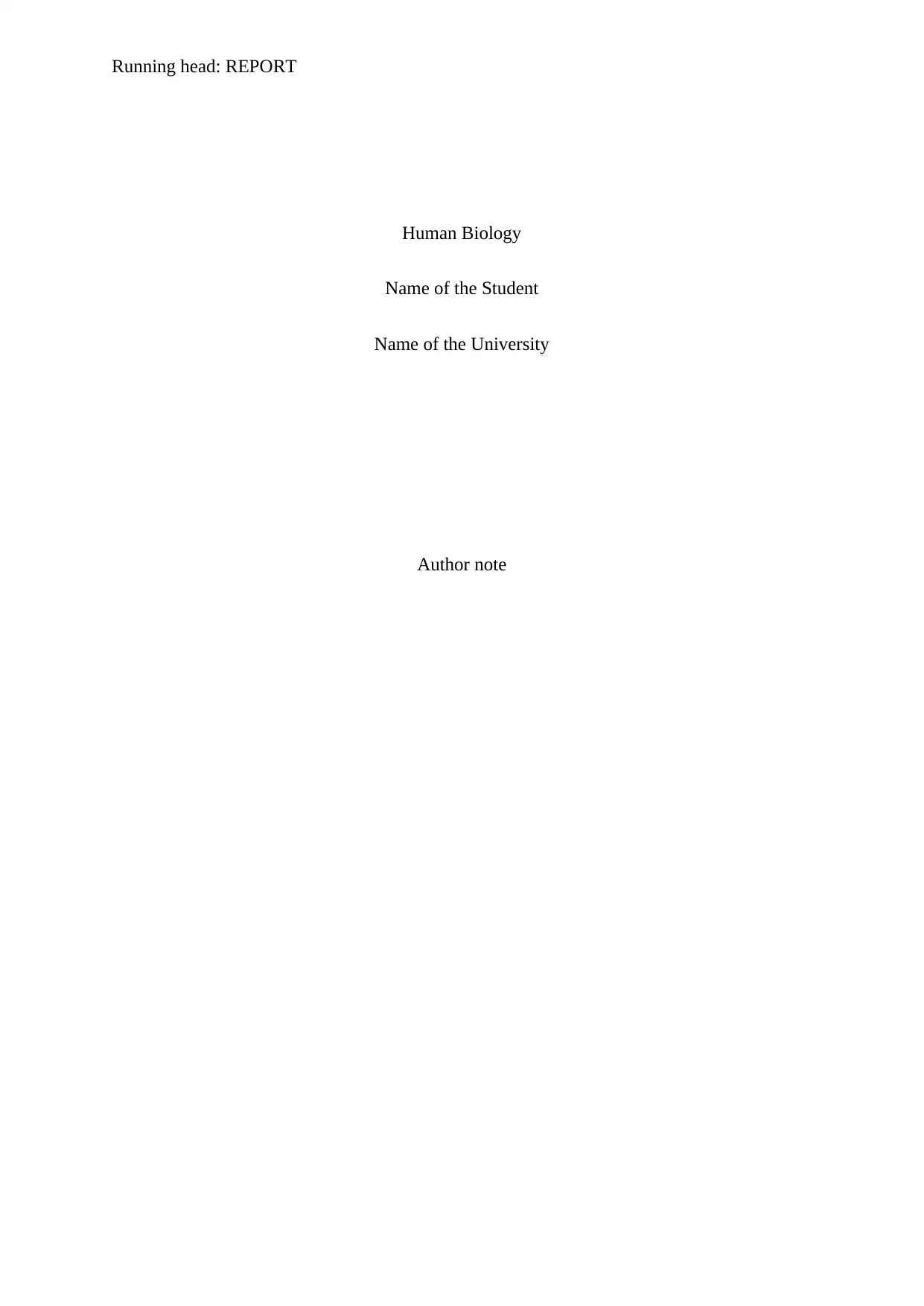
Running head: REPORT
Human Biology
Name of the Student
Name of the University
Author note
Human Biology
Name of the Student
Name of the University
Author note
Paraphrase This Document
Need a fresh take? Get an instant paraphrase of this document with our AI Paraphraser
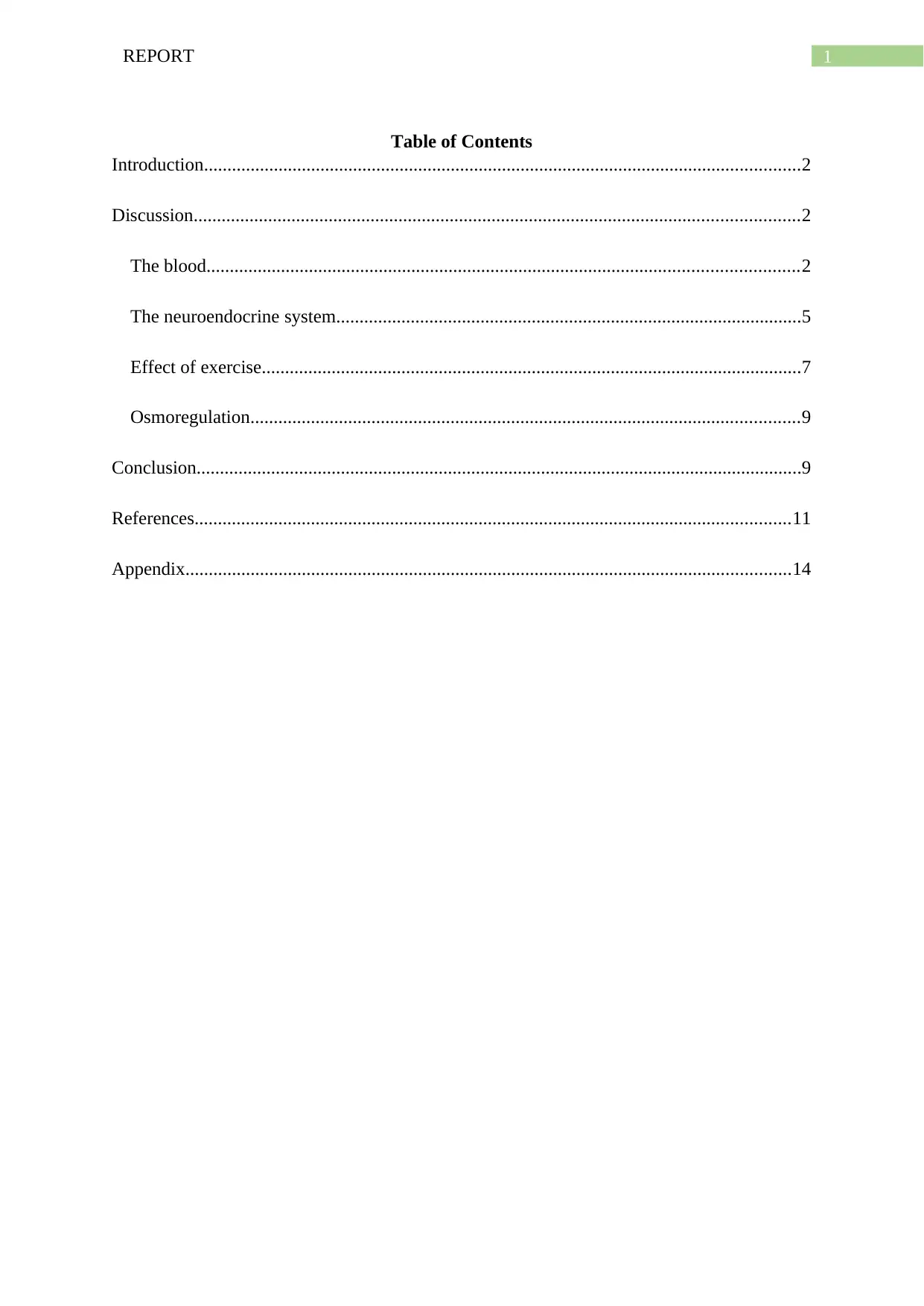
1REPORT
Table of Contents
Introduction................................................................................................................................2
Discussion..................................................................................................................................2
The blood...............................................................................................................................2
The neuroendocrine system....................................................................................................5
Effect of exercise....................................................................................................................7
Osmoregulation......................................................................................................................9
Conclusion..................................................................................................................................9
References................................................................................................................................11
Appendix..................................................................................................................................14
Table of Contents
Introduction................................................................................................................................2
Discussion..................................................................................................................................2
The blood...............................................................................................................................2
The neuroendocrine system....................................................................................................5
Effect of exercise....................................................................................................................7
Osmoregulation......................................................................................................................9
Conclusion..................................................................................................................................9
References................................................................................................................................11
Appendix..................................................................................................................................14
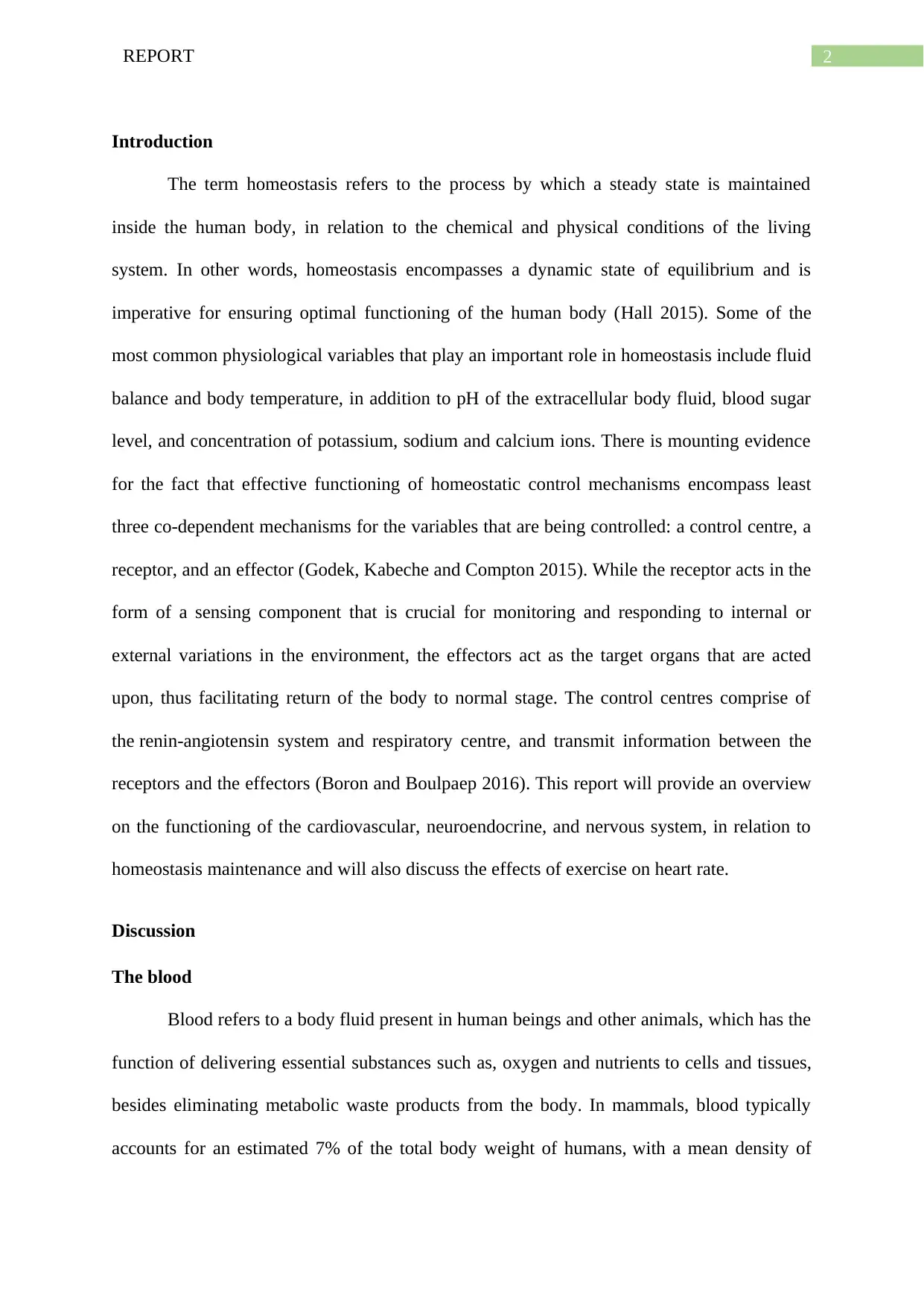
2REPORT
Introduction
The term homeostasis refers to the process by which a steady state is maintained
inside the human body, in relation to the chemical and physical conditions of the living
system. In other words, homeostasis encompasses a dynamic state of equilibrium and is
imperative for ensuring optimal functioning of the human body (Hall 2015). Some of the
most common physiological variables that play an important role in homeostasis include fluid
balance and body temperature, in addition to pH of the extracellular body fluid, blood sugar
level, and concentration of potassium, sodium and calcium ions. There is mounting evidence
for the fact that effective functioning of homeostatic control mechanisms encompass least
three co-dependent mechanisms for the variables that are being controlled: a control centre, a
receptor, and an effector (Godek, Kabeche and Compton 2015). While the receptor acts in the
form of a sensing component that is crucial for monitoring and responding to internal or
external variations in the environment, the effectors act as the target organs that are acted
upon, thus facilitating return of the body to normal stage. The control centres comprise of
the renin-angiotensin system and respiratory centre, and transmit information between the
receptors and the effectors (Boron and Boulpaep 2016). This report will provide an overview
on the functioning of the cardiovascular, neuroendocrine, and nervous system, in relation to
homeostasis maintenance and will also discuss the effects of exercise on heart rate.
Discussion
The blood
Blood refers to a body fluid present in human beings and other animals, which has the
function of delivering essential substances such as, oxygen and nutrients to cells and tissues,
besides eliminating metabolic waste products from the body. In mammals, blood typically
accounts for an estimated 7% of the total body weight of humans, with a mean density of
Introduction
The term homeostasis refers to the process by which a steady state is maintained
inside the human body, in relation to the chemical and physical conditions of the living
system. In other words, homeostasis encompasses a dynamic state of equilibrium and is
imperative for ensuring optimal functioning of the human body (Hall 2015). Some of the
most common physiological variables that play an important role in homeostasis include fluid
balance and body temperature, in addition to pH of the extracellular body fluid, blood sugar
level, and concentration of potassium, sodium and calcium ions. There is mounting evidence
for the fact that effective functioning of homeostatic control mechanisms encompass least
three co-dependent mechanisms for the variables that are being controlled: a control centre, a
receptor, and an effector (Godek, Kabeche and Compton 2015). While the receptor acts in the
form of a sensing component that is crucial for monitoring and responding to internal or
external variations in the environment, the effectors act as the target organs that are acted
upon, thus facilitating return of the body to normal stage. The control centres comprise of
the renin-angiotensin system and respiratory centre, and transmit information between the
receptors and the effectors (Boron and Boulpaep 2016). This report will provide an overview
on the functioning of the cardiovascular, neuroendocrine, and nervous system, in relation to
homeostasis maintenance and will also discuss the effects of exercise on heart rate.
Discussion
The blood
Blood refers to a body fluid present in human beings and other animals, which has the
function of delivering essential substances such as, oxygen and nutrients to cells and tissues,
besides eliminating metabolic waste products from the body. In mammals, blood typically
accounts for an estimated 7% of the total body weight of humans, with a mean density of
⊘ This is a preview!⊘
Do you want full access?
Subscribe today to unlock all pages.

Trusted by 1+ million students worldwide
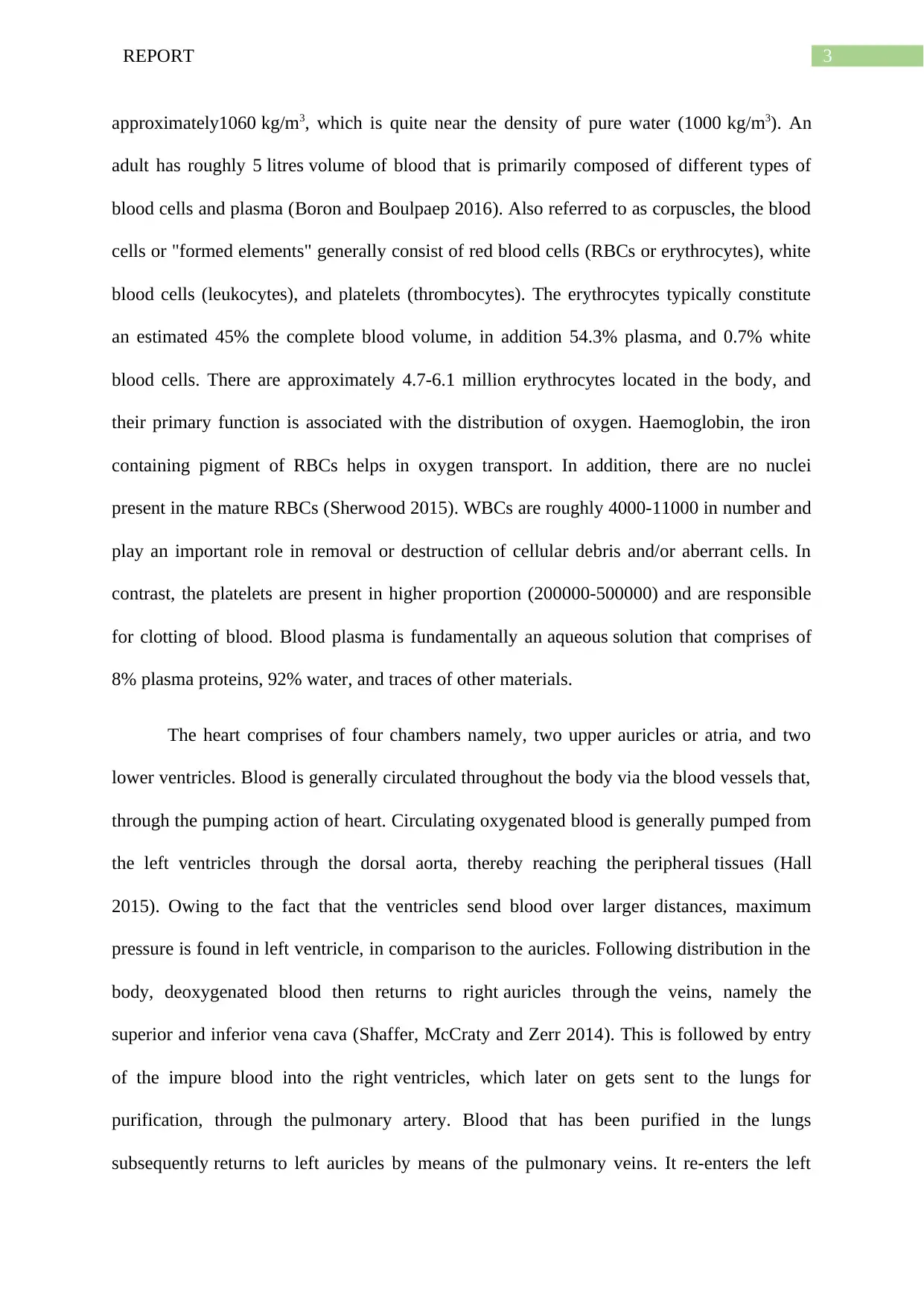
3REPORT
approximately1060 kg/m3, which is quite near the density of pure water (1000 kg/m3). An
adult has roughly 5 litres volume of blood that is primarily composed of different types of
blood cells and plasma (Boron and Boulpaep 2016). Also referred to as corpuscles, the blood
cells or "formed elements" generally consist of red blood cells (RBCs or erythrocytes), white
blood cells (leukocytes), and platelets (thrombocytes). The erythrocytes typically constitute
an estimated 45% the complete blood volume, in addition 54.3% plasma, and 0.7% white
blood cells. There are approximately 4.7-6.1 million erythrocytes located in the body, and
their primary function is associated with the distribution of oxygen. Haemoglobin, the iron
containing pigment of RBCs helps in oxygen transport. In addition, there are no nuclei
present in the mature RBCs (Sherwood 2015). WBCs are roughly 4000-11000 in number and
play an important role in removal or destruction of cellular debris and/or aberrant cells. In
contrast, the platelets are present in higher proportion (200000-500000) and are responsible
for clotting of blood. Blood plasma is fundamentally an aqueous solution that comprises of
8% plasma proteins, 92% water, and traces of other materials.
The heart comprises of four chambers namely, two upper auricles or atria, and two
lower ventricles. Blood is generally circulated throughout the body via the blood vessels that,
through the pumping action of heart. Circulating oxygenated blood is generally pumped from
the left ventricles through the dorsal aorta, thereby reaching the peripheral tissues (Hall
2015). Owing to the fact that the ventricles send blood over larger distances, maximum
pressure is found in left ventricle, in comparison to the auricles. Following distribution in the
body, deoxygenated blood then returns to right auricles through the veins, namely the
superior and inferior vena cava (Shaffer, McCraty and Zerr 2014). This is followed by entry
of the impure blood into the right ventricles, which later on gets sent to the lungs for
purification, through the pulmonary artery. Blood that has been purified in the lungs
subsequently returns to left auricles by means of the pulmonary veins. It re-enters the left
approximately1060 kg/m3, which is quite near the density of pure water (1000 kg/m3). An
adult has roughly 5 litres volume of blood that is primarily composed of different types of
blood cells and plasma (Boron and Boulpaep 2016). Also referred to as corpuscles, the blood
cells or "formed elements" generally consist of red blood cells (RBCs or erythrocytes), white
blood cells (leukocytes), and platelets (thrombocytes). The erythrocytes typically constitute
an estimated 45% the complete blood volume, in addition 54.3% plasma, and 0.7% white
blood cells. There are approximately 4.7-6.1 million erythrocytes located in the body, and
their primary function is associated with the distribution of oxygen. Haemoglobin, the iron
containing pigment of RBCs helps in oxygen transport. In addition, there are no nuclei
present in the mature RBCs (Sherwood 2015). WBCs are roughly 4000-11000 in number and
play an important role in removal or destruction of cellular debris and/or aberrant cells. In
contrast, the platelets are present in higher proportion (200000-500000) and are responsible
for clotting of blood. Blood plasma is fundamentally an aqueous solution that comprises of
8% plasma proteins, 92% water, and traces of other materials.
The heart comprises of four chambers namely, two upper auricles or atria, and two
lower ventricles. Blood is generally circulated throughout the body via the blood vessels that,
through the pumping action of heart. Circulating oxygenated blood is generally pumped from
the left ventricles through the dorsal aorta, thereby reaching the peripheral tissues (Hall
2015). Owing to the fact that the ventricles send blood over larger distances, maximum
pressure is found in left ventricle, in comparison to the auricles. Following distribution in the
body, deoxygenated blood then returns to right auricles through the veins, namely the
superior and inferior vena cava (Shaffer, McCraty and Zerr 2014). This is followed by entry
of the impure blood into the right ventricles, which later on gets sent to the lungs for
purification, through the pulmonary artery. Blood that has been purified in the lungs
subsequently returns to left auricles by means of the pulmonary veins. It re-enters the left
Paraphrase This Document
Need a fresh take? Get an instant paraphrase of this document with our AI Paraphraser
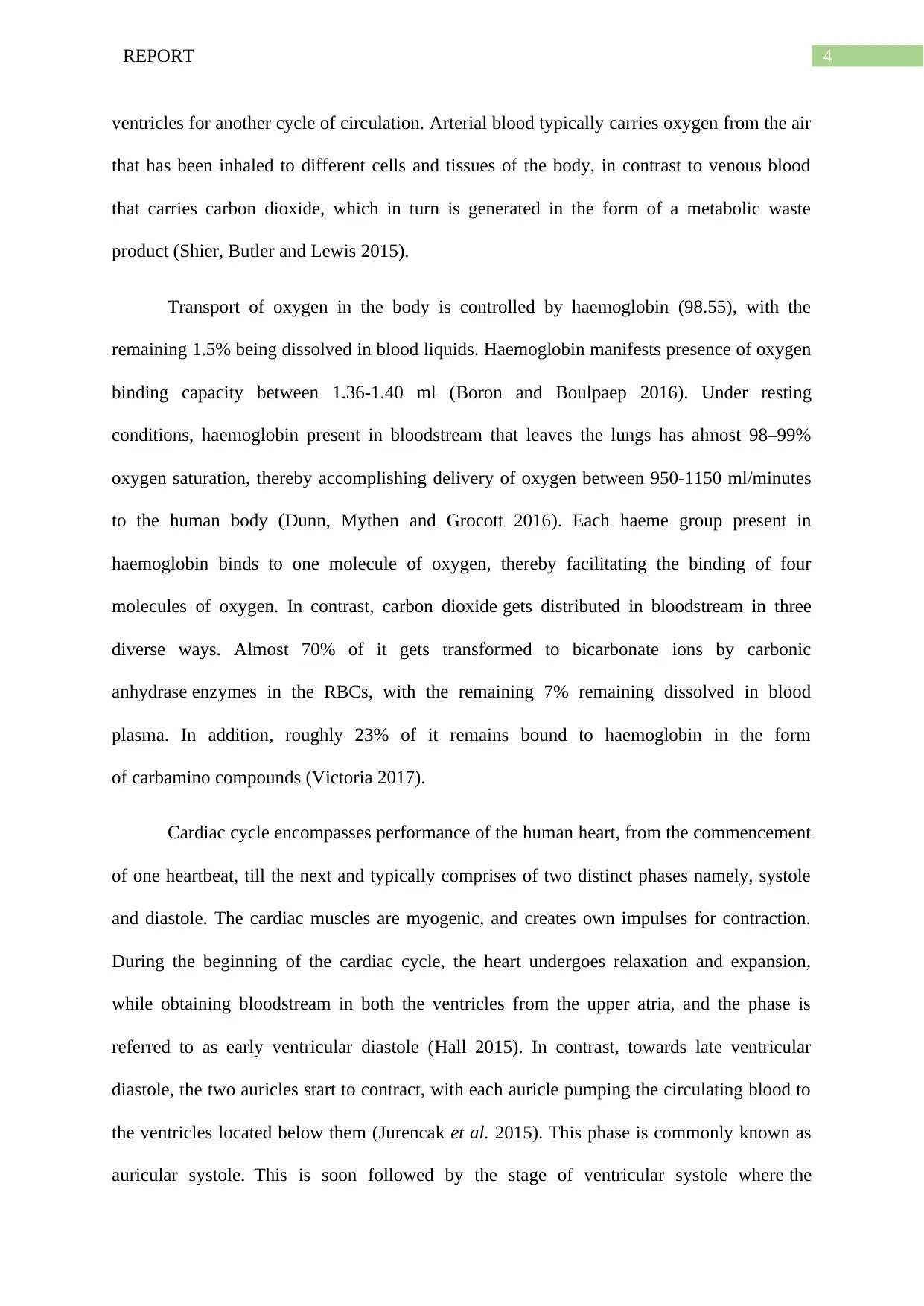
4REPORT
ventricles for another cycle of circulation. Arterial blood typically carries oxygen from the air
that has been inhaled to different cells and tissues of the body, in contrast to venous blood
that carries carbon dioxide, which in turn is generated in the form of a metabolic waste
product (Shier, Butler and Lewis 2015).
Transport of oxygen in the body is controlled by haemoglobin (98.55), with the
remaining 1.5% being dissolved in blood liquids. Haemoglobin manifests presence of oxygen
binding capacity between 1.36-1.40 ml (Boron and Boulpaep 2016). Under resting
conditions, haemoglobin present in bloodstream that leaves the lungs has almost 98–99%
oxygen saturation, thereby accomplishing delivery of oxygen between 950-1150 ml/minutes
to the human body (Dunn, Mythen and Grocott 2016). Each haeme group present in
haemoglobin binds to one molecule of oxygen, thereby facilitating the binding of four
molecules of oxygen. In contrast, carbon dioxide gets distributed in bloodstream in three
diverse ways. Almost 70% of it gets transformed to bicarbonate ions by carbonic
anhydrase enzymes in the RBCs, with the remaining 7% remaining dissolved in blood
plasma. In addition, roughly 23% of it remains bound to haemoglobin in the form
of carbamino compounds (Victoria 2017).
Cardiac cycle encompasses performance of the human heart, from the commencement
of one heartbeat, till the next and typically comprises of two distinct phases namely, systole
and diastole. The cardiac muscles are myogenic, and creates own impulses for contraction.
During the beginning of the cardiac cycle, the heart undergoes relaxation and expansion,
while obtaining bloodstream in both the ventricles from the upper atria, and the phase is
referred to as early ventricular diastole (Hall 2015). In contrast, towards late ventricular
diastole, the two auricles start to contract, with each auricle pumping the circulating blood to
the ventricles located below them (Jurencak et al. 2015). This phase is commonly known as
auricular systole. This is soon followed by the stage of ventricular systole where the
ventricles for another cycle of circulation. Arterial blood typically carries oxygen from the air
that has been inhaled to different cells and tissues of the body, in contrast to venous blood
that carries carbon dioxide, which in turn is generated in the form of a metabolic waste
product (Shier, Butler and Lewis 2015).
Transport of oxygen in the body is controlled by haemoglobin (98.55), with the
remaining 1.5% being dissolved in blood liquids. Haemoglobin manifests presence of oxygen
binding capacity between 1.36-1.40 ml (Boron and Boulpaep 2016). Under resting
conditions, haemoglobin present in bloodstream that leaves the lungs has almost 98–99%
oxygen saturation, thereby accomplishing delivery of oxygen between 950-1150 ml/minutes
to the human body (Dunn, Mythen and Grocott 2016). Each haeme group present in
haemoglobin binds to one molecule of oxygen, thereby facilitating the binding of four
molecules of oxygen. In contrast, carbon dioxide gets distributed in bloodstream in three
diverse ways. Almost 70% of it gets transformed to bicarbonate ions by carbonic
anhydrase enzymes in the RBCs, with the remaining 7% remaining dissolved in blood
plasma. In addition, roughly 23% of it remains bound to haemoglobin in the form
of carbamino compounds (Victoria 2017).
Cardiac cycle encompasses performance of the human heart, from the commencement
of one heartbeat, till the next and typically comprises of two distinct phases namely, systole
and diastole. The cardiac muscles are myogenic, and creates own impulses for contraction.
During the beginning of the cardiac cycle, the heart undergoes relaxation and expansion,
while obtaining bloodstream in both the ventricles from the upper atria, and the phase is
referred to as early ventricular diastole (Hall 2015). In contrast, towards late ventricular
diastole, the two auricles start to contract, with each auricle pumping the circulating blood to
the ventricles located below them (Jurencak et al. 2015). This phase is commonly known as
auricular systole. This is soon followed by the stage of ventricular systole where the
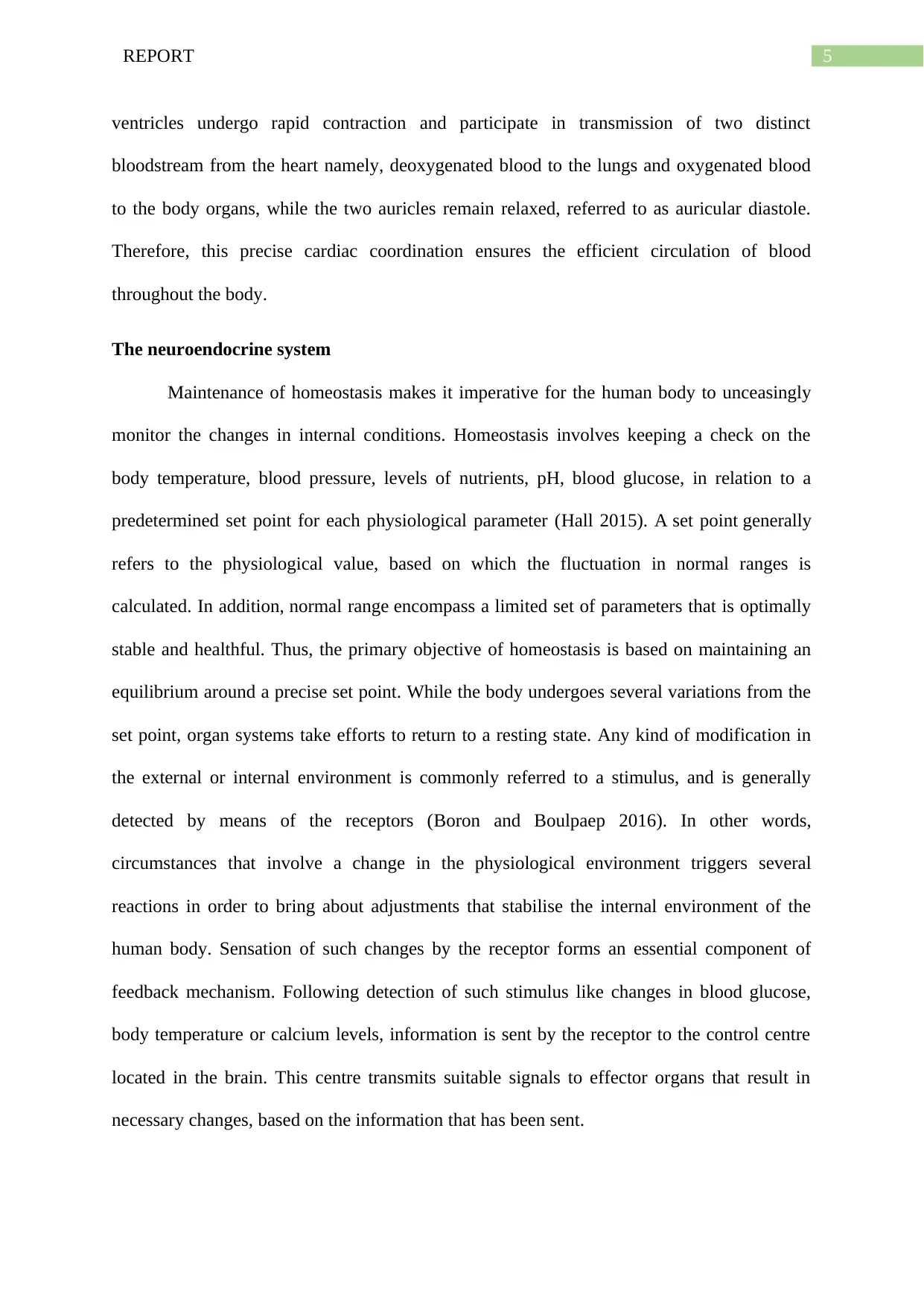
5REPORT
ventricles undergo rapid contraction and participate in transmission of two distinct
bloodstream from the heart namely, deoxygenated blood to the lungs and oxygenated blood
to the body organs, while the two auricles remain relaxed, referred to as auricular diastole.
Therefore, this precise cardiac coordination ensures the efficient circulation of blood
throughout the body.
The neuroendocrine system
Maintenance of homeostasis makes it imperative for the human body to unceasingly
monitor the changes in internal conditions. Homeostasis involves keeping a check on the
body temperature, blood pressure, levels of nutrients, pH, blood glucose, in relation to a
predetermined set point for each physiological parameter (Hall 2015). A set point generally
refers to the physiological value, based on which the fluctuation in normal ranges is
calculated. In addition, normal range encompass a limited set of parameters that is optimally
stable and healthful. Thus, the primary objective of homeostasis is based on maintaining an
equilibrium around a precise set point. While the body undergoes several variations from the
set point, organ systems take efforts to return to a resting state. Any kind of modification in
the external or internal environment is commonly referred to a stimulus, and is generally
detected by means of the receptors (Boron and Boulpaep 2016). In other words,
circumstances that involve a change in the physiological environment triggers several
reactions in order to bring about adjustments that stabilise the internal environment of the
human body. Sensation of such changes by the receptor forms an essential component of
feedback mechanism. Following detection of such stimulus like changes in blood glucose,
body temperature or calcium levels, information is sent by the receptor to the control centre
located in the brain. This centre transmits suitable signals to effector organs that result in
necessary changes, based on the information that has been sent.
ventricles undergo rapid contraction and participate in transmission of two distinct
bloodstream from the heart namely, deoxygenated blood to the lungs and oxygenated blood
to the body organs, while the two auricles remain relaxed, referred to as auricular diastole.
Therefore, this precise cardiac coordination ensures the efficient circulation of blood
throughout the body.
The neuroendocrine system
Maintenance of homeostasis makes it imperative for the human body to unceasingly
monitor the changes in internal conditions. Homeostasis involves keeping a check on the
body temperature, blood pressure, levels of nutrients, pH, blood glucose, in relation to a
predetermined set point for each physiological parameter (Hall 2015). A set point generally
refers to the physiological value, based on which the fluctuation in normal ranges is
calculated. In addition, normal range encompass a limited set of parameters that is optimally
stable and healthful. Thus, the primary objective of homeostasis is based on maintaining an
equilibrium around a precise set point. While the body undergoes several variations from the
set point, organ systems take efforts to return to a resting state. Any kind of modification in
the external or internal environment is commonly referred to a stimulus, and is generally
detected by means of the receptors (Boron and Boulpaep 2016). In other words,
circumstances that involve a change in the physiological environment triggers several
reactions in order to bring about adjustments that stabilise the internal environment of the
human body. Sensation of such changes by the receptor forms an essential component of
feedback mechanism. Following detection of such stimulus like changes in blood glucose,
body temperature or calcium levels, information is sent by the receptor to the control centre
located in the brain. This centre transmits suitable signals to effector organs that result in
necessary changes, based on the information that has been sent.
⊘ This is a preview!⊘
Do you want full access?
Subscribe today to unlock all pages.

Trusted by 1+ million students worldwide
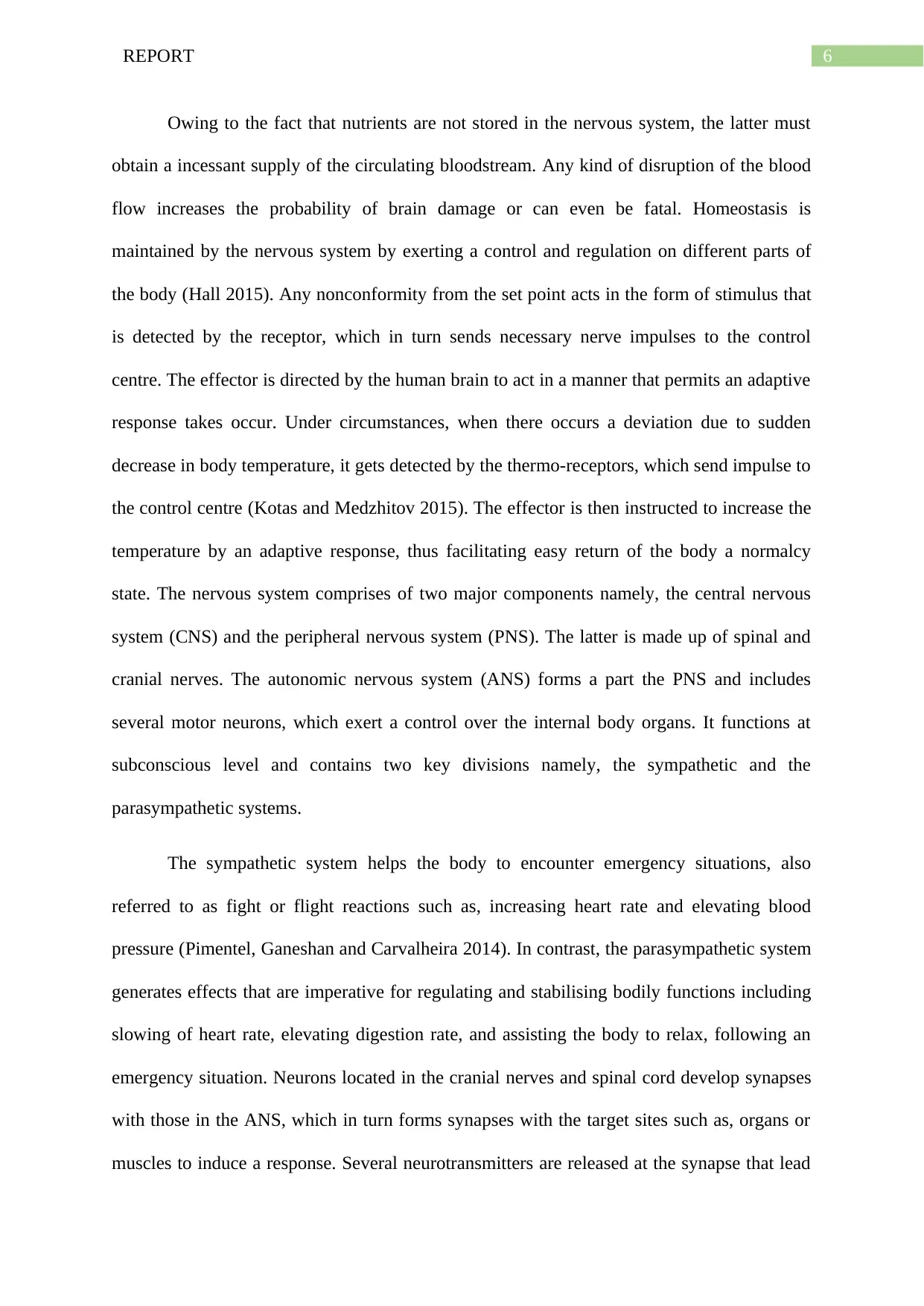
6REPORT
Owing to the fact that nutrients are not stored in the nervous system, the latter must
obtain a incessant supply of the circulating bloodstream. Any kind of disruption of the blood
flow increases the probability of brain damage or can even be fatal. Homeostasis is
maintained by the nervous system by exerting a control and regulation on different parts of
the body (Hall 2015). Any nonconformity from the set point acts in the form of stimulus that
is detected by the receptor, which in turn sends necessary nerve impulses to the control
centre. The effector is directed by the human brain to act in a manner that permits an adaptive
response takes occur. Under circumstances, when there occurs a deviation due to sudden
decrease in body temperature, it gets detected by the thermo-receptors, which send impulse to
the control centre (Kotas and Medzhitov 2015). The effector is then instructed to increase the
temperature by an adaptive response, thus facilitating easy return of the body a normalcy
state. The nervous system comprises of two major components namely, the central nervous
system (CNS) and the peripheral nervous system (PNS). The latter is made up of spinal and
cranial nerves. The autonomic nervous system (ANS) forms a part the PNS and includes
several motor neurons, which exert a control over the internal body organs. It functions at
subconscious level and contains two key divisions namely, the sympathetic and the
parasympathetic systems.
The sympathetic system helps the body to encounter emergency situations, also
referred to as fight or flight reactions such as, increasing heart rate and elevating blood
pressure (Pimentel, Ganeshan and Carvalheira 2014). In contrast, the parasympathetic system
generates effects that are imperative for regulating and stabilising bodily functions including
slowing of heart rate, elevating digestion rate, and assisting the body to relax, following an
emergency situation. Neurons located in the cranial nerves and spinal cord develop synapses
with those in the ANS, which in turn forms synapses with the target sites such as, organs or
muscles to induce a response. Several neurotransmitters are released at the synapse that lead
Owing to the fact that nutrients are not stored in the nervous system, the latter must
obtain a incessant supply of the circulating bloodstream. Any kind of disruption of the blood
flow increases the probability of brain damage or can even be fatal. Homeostasis is
maintained by the nervous system by exerting a control and regulation on different parts of
the body (Hall 2015). Any nonconformity from the set point acts in the form of stimulus that
is detected by the receptor, which in turn sends necessary nerve impulses to the control
centre. The effector is directed by the human brain to act in a manner that permits an adaptive
response takes occur. Under circumstances, when there occurs a deviation due to sudden
decrease in body temperature, it gets detected by the thermo-receptors, which send impulse to
the control centre (Kotas and Medzhitov 2015). The effector is then instructed to increase the
temperature by an adaptive response, thus facilitating easy return of the body a normalcy
state. The nervous system comprises of two major components namely, the central nervous
system (CNS) and the peripheral nervous system (PNS). The latter is made up of spinal and
cranial nerves. The autonomic nervous system (ANS) forms a part the PNS and includes
several motor neurons, which exert a control over the internal body organs. It functions at
subconscious level and contains two key divisions namely, the sympathetic and the
parasympathetic systems.
The sympathetic system helps the body to encounter emergency situations, also
referred to as fight or flight reactions such as, increasing heart rate and elevating blood
pressure (Pimentel, Ganeshan and Carvalheira 2014). In contrast, the parasympathetic system
generates effects that are imperative for regulating and stabilising bodily functions including
slowing of heart rate, elevating digestion rate, and assisting the body to relax, following an
emergency situation. Neurons located in the cranial nerves and spinal cord develop synapses
with those in the ANS, which in turn forms synapses with the target sites such as, organs or
muscles to induce a response. Several neurotransmitters are released at the synapse that lead
Paraphrase This Document
Need a fresh take? Get an instant paraphrase of this document with our AI Paraphraser
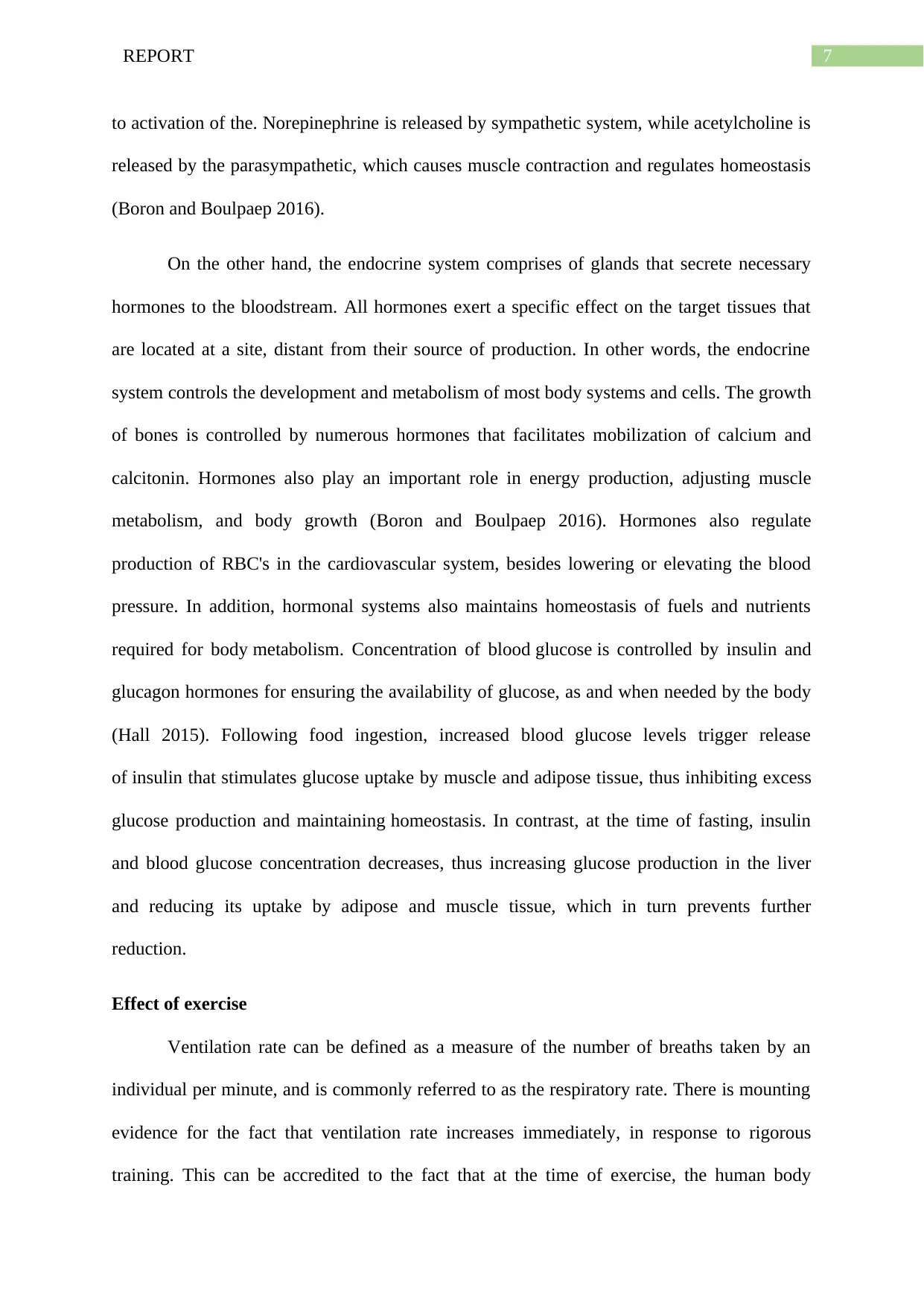
7REPORT
to activation of the. Norepinephrine is released by sympathetic system, while acetylcholine is
released by the parasympathetic, which causes muscle contraction and regulates homeostasis
(Boron and Boulpaep 2016).
On the other hand, the endocrine system comprises of glands that secrete necessary
hormones to the bloodstream. All hormones exert a specific effect on the target tissues that
are located at a site, distant from their source of production. In other words, the endocrine
system controls the development and metabolism of most body systems and cells. The growth
of bones is controlled by numerous hormones that facilitates mobilization of calcium and
calcitonin. Hormones also play an important role in energy production, adjusting muscle
metabolism, and body growth (Boron and Boulpaep 2016). Hormones also regulate
production of RBC's in the cardiovascular system, besides lowering or elevating the blood
pressure. In addition, hormonal systems also maintains homeostasis of fuels and nutrients
required for body metabolism. Concentration of blood glucose is controlled by insulin and
glucagon hormones for ensuring the availability of glucose, as and when needed by the body
(Hall 2015). Following food ingestion, increased blood glucose levels trigger release
of insulin that stimulates glucose uptake by muscle and adipose tissue, thus inhibiting excess
glucose production and maintaining homeostasis. In contrast, at the time of fasting, insulin
and blood glucose concentration decreases, thus increasing glucose production in the liver
and reducing its uptake by adipose and muscle tissue, which in turn prevents further
reduction.
Effect of exercise
Ventilation rate can be defined as a measure of the number of breaths taken by an
individual per minute, and is commonly referred to as the respiratory rate. There is mounting
evidence for the fact that ventilation rate increases immediately, in response to rigorous
training. This can be accredited to the fact that at the time of exercise, the human body
to activation of the. Norepinephrine is released by sympathetic system, while acetylcholine is
released by the parasympathetic, which causes muscle contraction and regulates homeostasis
(Boron and Boulpaep 2016).
On the other hand, the endocrine system comprises of glands that secrete necessary
hormones to the bloodstream. All hormones exert a specific effect on the target tissues that
are located at a site, distant from their source of production. In other words, the endocrine
system controls the development and metabolism of most body systems and cells. The growth
of bones is controlled by numerous hormones that facilitates mobilization of calcium and
calcitonin. Hormones also play an important role in energy production, adjusting muscle
metabolism, and body growth (Boron and Boulpaep 2016). Hormones also regulate
production of RBC's in the cardiovascular system, besides lowering or elevating the blood
pressure. In addition, hormonal systems also maintains homeostasis of fuels and nutrients
required for body metabolism. Concentration of blood glucose is controlled by insulin and
glucagon hormones for ensuring the availability of glucose, as and when needed by the body
(Hall 2015). Following food ingestion, increased blood glucose levels trigger release
of insulin that stimulates glucose uptake by muscle and adipose tissue, thus inhibiting excess
glucose production and maintaining homeostasis. In contrast, at the time of fasting, insulin
and blood glucose concentration decreases, thus increasing glucose production in the liver
and reducing its uptake by adipose and muscle tissue, which in turn prevents further
reduction.
Effect of exercise
Ventilation rate can be defined as a measure of the number of breaths taken by an
individual per minute, and is commonly referred to as the respiratory rate. There is mounting
evidence for the fact that ventilation rate increases immediately, in response to rigorous
training. This can be accredited to the fact that at the time of exercise, the human body
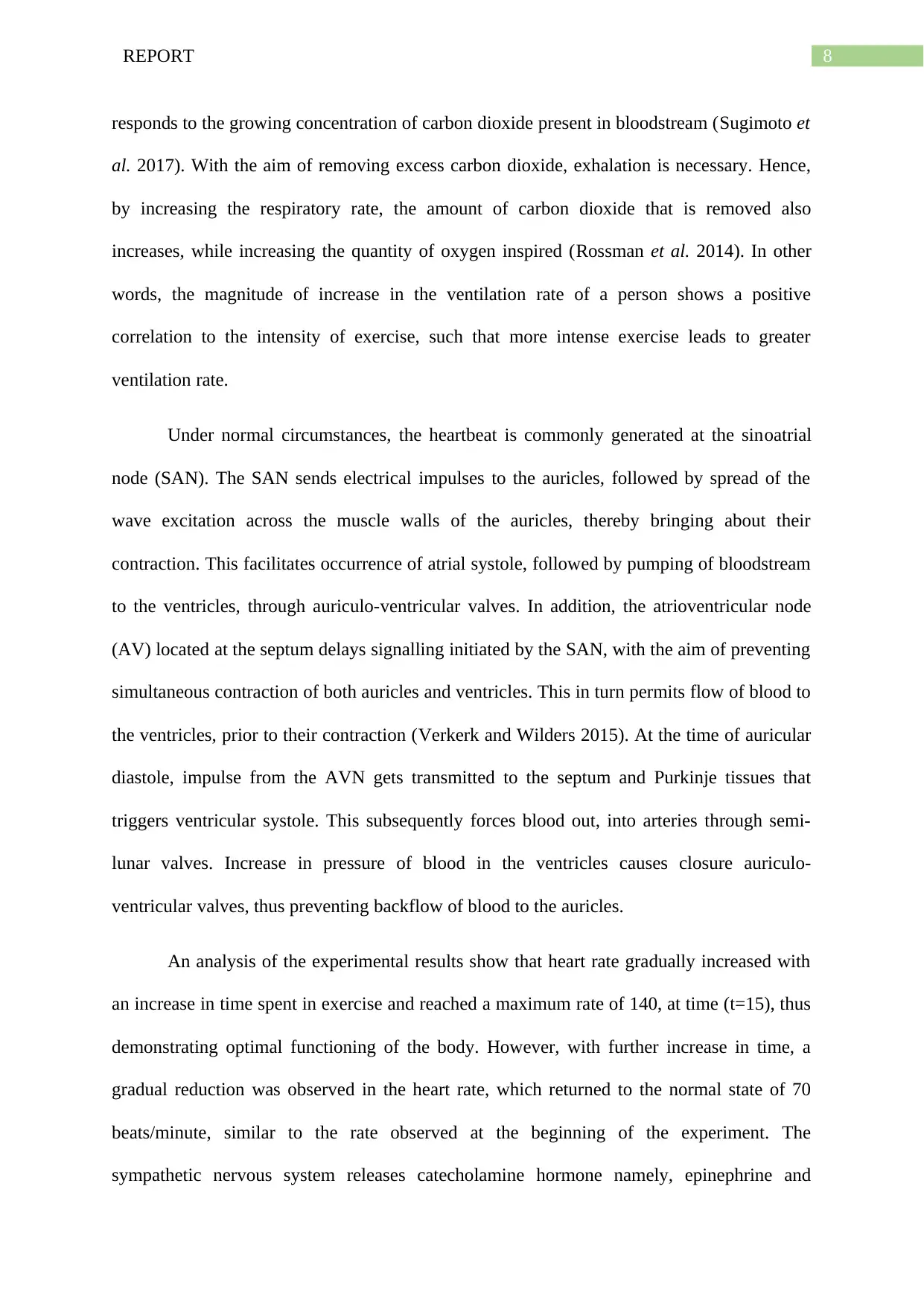
8REPORT
responds to the growing concentration of carbon dioxide present in bloodstream (Sugimoto et
al. 2017). With the aim of removing excess carbon dioxide, exhalation is necessary. Hence,
by increasing the respiratory rate, the amount of carbon dioxide that is removed also
increases, while increasing the quantity of oxygen inspired (Rossman et al. 2014). In other
words, the magnitude of increase in the ventilation rate of a person shows a positive
correlation to the intensity of exercise, such that more intense exercise leads to greater
ventilation rate.
Under normal circumstances, the heartbeat is commonly generated at the sinoatrial
node (SAN). The SAN sends electrical impulses to the auricles, followed by spread of the
wave excitation across the muscle walls of the auricles, thereby bringing about their
contraction. This facilitates occurrence of atrial systole, followed by pumping of bloodstream
to the ventricles, through auriculo-ventricular valves. In addition, the atrioventricular node
(AV) located at the septum delays signalling initiated by the SAN, with the aim of preventing
simultaneous contraction of both auricles and ventricles. This in turn permits flow of blood to
the ventricles, prior to their contraction (Verkerk and Wilders 2015). At the time of auricular
diastole, impulse from the AVN gets transmitted to the septum and Purkinje tissues that
triggers ventricular systole. This subsequently forces blood out, into arteries through semi-
lunar valves. Increase in pressure of blood in the ventricles causes closure auriculo-
ventricular valves, thus preventing backflow of blood to the auricles.
An analysis of the experimental results show that heart rate gradually increased with
an increase in time spent in exercise and reached a maximum rate of 140, at time (t=15), thus
demonstrating optimal functioning of the body. However, with further increase in time, a
gradual reduction was observed in the heart rate, which returned to the normal state of 70
beats/minute, similar to the rate observed at the beginning of the experiment. The
sympathetic nervous system releases catecholamine hormone namely, epinephrine and
responds to the growing concentration of carbon dioxide present in bloodstream (Sugimoto et
al. 2017). With the aim of removing excess carbon dioxide, exhalation is necessary. Hence,
by increasing the respiratory rate, the amount of carbon dioxide that is removed also
increases, while increasing the quantity of oxygen inspired (Rossman et al. 2014). In other
words, the magnitude of increase in the ventilation rate of a person shows a positive
correlation to the intensity of exercise, such that more intense exercise leads to greater
ventilation rate.
Under normal circumstances, the heartbeat is commonly generated at the sinoatrial
node (SAN). The SAN sends electrical impulses to the auricles, followed by spread of the
wave excitation across the muscle walls of the auricles, thereby bringing about their
contraction. This facilitates occurrence of atrial systole, followed by pumping of bloodstream
to the ventricles, through auriculo-ventricular valves. In addition, the atrioventricular node
(AV) located at the septum delays signalling initiated by the SAN, with the aim of preventing
simultaneous contraction of both auricles and ventricles. This in turn permits flow of blood to
the ventricles, prior to their contraction (Verkerk and Wilders 2015). At the time of auricular
diastole, impulse from the AVN gets transmitted to the septum and Purkinje tissues that
triggers ventricular systole. This subsequently forces blood out, into arteries through semi-
lunar valves. Increase in pressure of blood in the ventricles causes closure auriculo-
ventricular valves, thus preventing backflow of blood to the auricles.
An analysis of the experimental results show that heart rate gradually increased with
an increase in time spent in exercise and reached a maximum rate of 140, at time (t=15), thus
demonstrating optimal functioning of the body. However, with further increase in time, a
gradual reduction was observed in the heart rate, which returned to the normal state of 70
beats/minute, similar to the rate observed at the beginning of the experiment. The
sympathetic nervous system releases catecholamine hormone namely, epinephrine and
⊘ This is a preview!⊘
Do you want full access?
Subscribe today to unlock all pages.

Trusted by 1+ million students worldwide
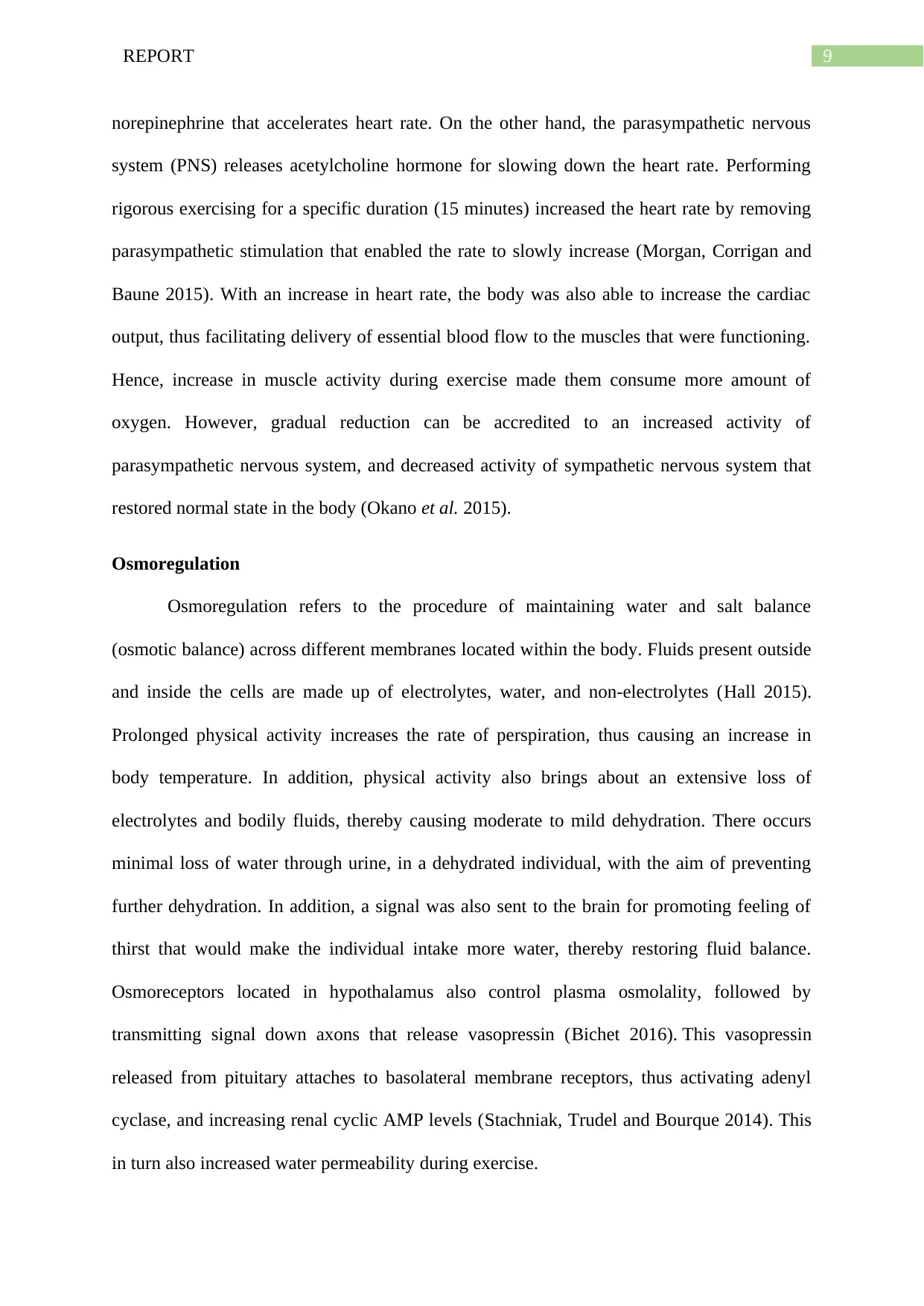
9REPORT
norepinephrine that accelerates heart rate. On the other hand, the parasympathetic nervous
system (PNS) releases acetylcholine hormone for slowing down the heart rate. Performing
rigorous exercising for a specific duration (15 minutes) increased the heart rate by removing
parasympathetic stimulation that enabled the rate to slowly increase (Morgan, Corrigan and
Baune 2015). With an increase in heart rate, the body was also able to increase the cardiac
output, thus facilitating delivery of essential blood flow to the muscles that were functioning.
Hence, increase in muscle activity during exercise made them consume more amount of
oxygen. However, gradual reduction can be accredited to an increased activity of
parasympathetic nervous system, and decreased activity of sympathetic nervous system that
restored normal state in the body (Okano et al. 2015).
Osmoregulation
Osmoregulation refers to the procedure of maintaining water and salt balance
(osmotic balance) across different membranes located within the body. Fluids present outside
and inside the cells are made up of electrolytes, water, and non-electrolytes (Hall 2015).
Prolonged physical activity increases the rate of perspiration, thus causing an increase in
body temperature. In addition, physical activity also brings about an extensive loss of
electrolytes and bodily fluids, thereby causing moderate to mild dehydration. There occurs
minimal loss of water through urine, in a dehydrated individual, with the aim of preventing
further dehydration. In addition, a signal was also sent to the brain for promoting feeling of
thirst that would make the individual intake more water, thereby restoring fluid balance.
Osmoreceptors located in hypothalamus also control plasma osmolality, followed by
transmitting signal down axons that release vasopressin (Bichet 2016). This vasopressin
released from pituitary attaches to basolateral membrane receptors, thus activating adenyl
cyclase, and increasing renal cyclic AMP levels (Stachniak, Trudel and Bourque 2014). This
in turn also increased water permeability during exercise.
norepinephrine that accelerates heart rate. On the other hand, the parasympathetic nervous
system (PNS) releases acetylcholine hormone for slowing down the heart rate. Performing
rigorous exercising for a specific duration (15 minutes) increased the heart rate by removing
parasympathetic stimulation that enabled the rate to slowly increase (Morgan, Corrigan and
Baune 2015). With an increase in heart rate, the body was also able to increase the cardiac
output, thus facilitating delivery of essential blood flow to the muscles that were functioning.
Hence, increase in muscle activity during exercise made them consume more amount of
oxygen. However, gradual reduction can be accredited to an increased activity of
parasympathetic nervous system, and decreased activity of sympathetic nervous system that
restored normal state in the body (Okano et al. 2015).
Osmoregulation
Osmoregulation refers to the procedure of maintaining water and salt balance
(osmotic balance) across different membranes located within the body. Fluids present outside
and inside the cells are made up of electrolytes, water, and non-electrolytes (Hall 2015).
Prolonged physical activity increases the rate of perspiration, thus causing an increase in
body temperature. In addition, physical activity also brings about an extensive loss of
electrolytes and bodily fluids, thereby causing moderate to mild dehydration. There occurs
minimal loss of water through urine, in a dehydrated individual, with the aim of preventing
further dehydration. In addition, a signal was also sent to the brain for promoting feeling of
thirst that would make the individual intake more water, thereby restoring fluid balance.
Osmoreceptors located in hypothalamus also control plasma osmolality, followed by
transmitting signal down axons that release vasopressin (Bichet 2016). This vasopressin
released from pituitary attaches to basolateral membrane receptors, thus activating adenyl
cyclase, and increasing renal cyclic AMP levels (Stachniak, Trudel and Bourque 2014). This
in turn also increased water permeability during exercise.
Paraphrase This Document
Need a fresh take? Get an instant paraphrase of this document with our AI Paraphraser
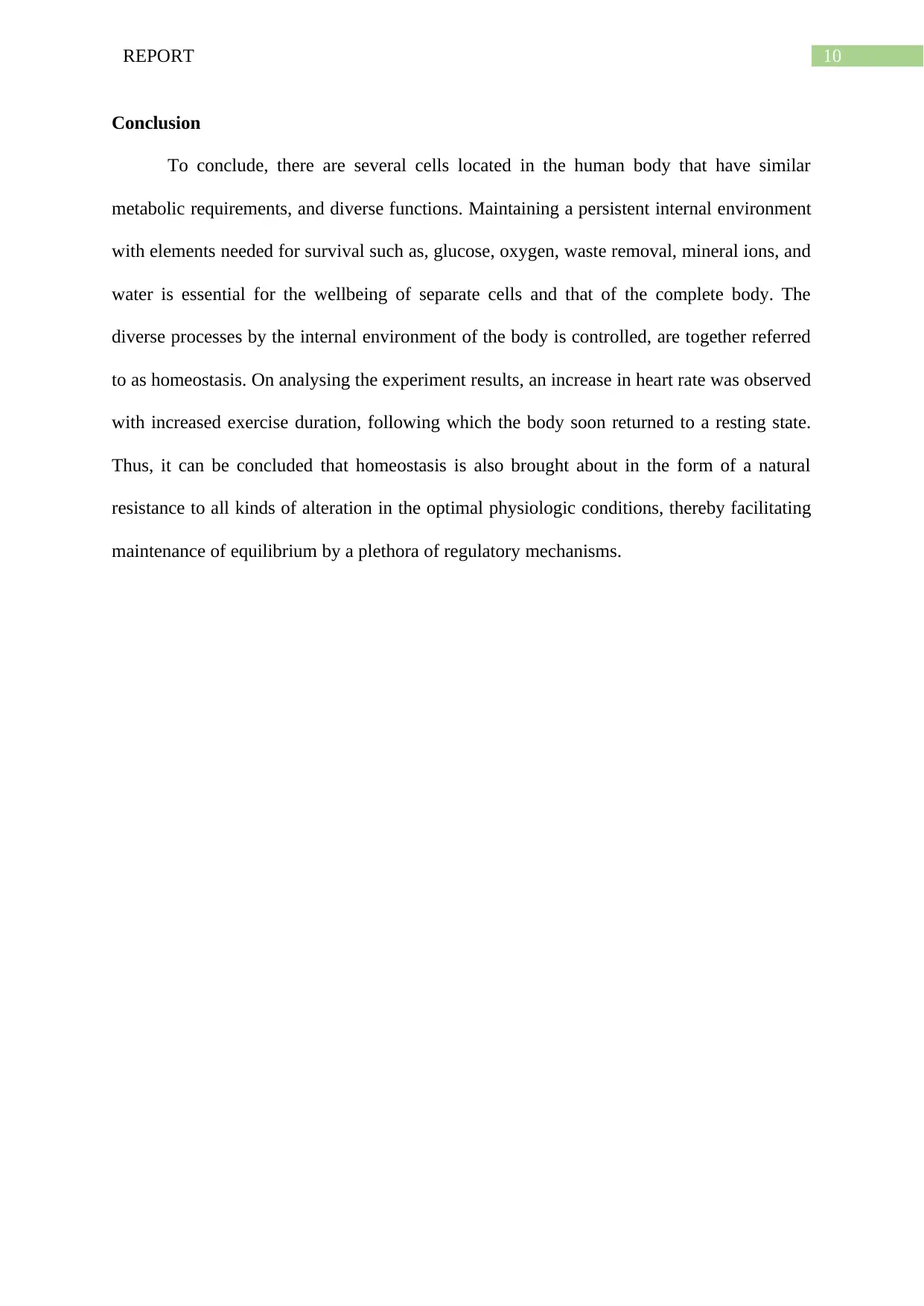
10REPORT
Conclusion
To conclude, there are several cells located in the human body that have similar
metabolic requirements, and diverse functions. Maintaining a persistent internal environment
with elements needed for survival such as, glucose, oxygen, waste removal, mineral ions, and
water is essential for the wellbeing of separate cells and that of the complete body. The
diverse processes by the internal environment of the body is controlled, are together referred
to as homeostasis. On analysing the experiment results, an increase in heart rate was observed
with increased exercise duration, following which the body soon returned to a resting state.
Thus, it can be concluded that homeostasis is also brought about in the form of a natural
resistance to all kinds of alteration in the optimal physiologic conditions, thereby facilitating
maintenance of equilibrium by a plethora of regulatory mechanisms.
Conclusion
To conclude, there are several cells located in the human body that have similar
metabolic requirements, and diverse functions. Maintaining a persistent internal environment
with elements needed for survival such as, glucose, oxygen, waste removal, mineral ions, and
water is essential for the wellbeing of separate cells and that of the complete body. The
diverse processes by the internal environment of the body is controlled, are together referred
to as homeostasis. On analysing the experiment results, an increase in heart rate was observed
with increased exercise duration, following which the body soon returned to a resting state.
Thus, it can be concluded that homeostasis is also brought about in the form of a natural
resistance to all kinds of alteration in the optimal physiologic conditions, thereby facilitating
maintenance of equilibrium by a plethora of regulatory mechanisms.
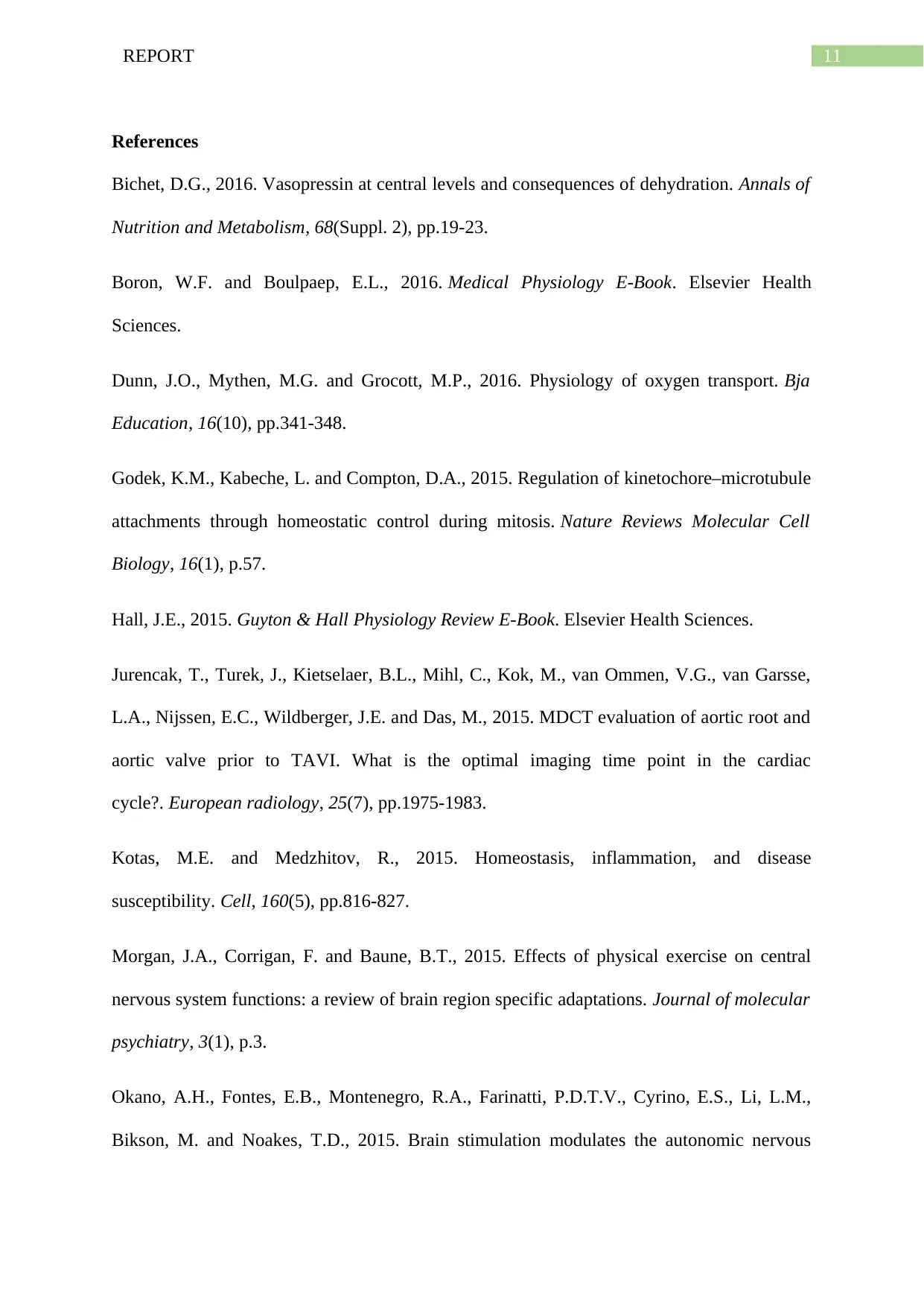
11REPORT
References
Bichet, D.G., 2016. Vasopressin at central levels and consequences of dehydration. Annals of
Nutrition and Metabolism, 68(Suppl. 2), pp.19-23.
Boron, W.F. and Boulpaep, E.L., 2016. Medical Physiology E-Book. Elsevier Health
Sciences.
Dunn, J.O., Mythen, M.G. and Grocott, M.P., 2016. Physiology of oxygen transport. Bja
Education, 16(10), pp.341-348.
Godek, K.M., Kabeche, L. and Compton, D.A., 2015. Regulation of kinetochore–microtubule
attachments through homeostatic control during mitosis. Nature Reviews Molecular Cell
Biology, 16(1), p.57.
Hall, J.E., 2015. Guyton & Hall Physiology Review E-Book. Elsevier Health Sciences.
Jurencak, T., Turek, J., Kietselaer, B.L., Mihl, C., Kok, M., van Ommen, V.G., van Garsse,
L.A., Nijssen, E.C., Wildberger, J.E. and Das, M., 2015. MDCT evaluation of aortic root and
aortic valve prior to TAVI. What is the optimal imaging time point in the cardiac
cycle?. European radiology, 25(7), pp.1975-1983.
Kotas, M.E. and Medzhitov, R., 2015. Homeostasis, inflammation, and disease
susceptibility. Cell, 160(5), pp.816-827.
Morgan, J.A., Corrigan, F. and Baune, B.T., 2015. Effects of physical exercise on central
nervous system functions: a review of brain region specific adaptations. Journal of molecular
psychiatry, 3(1), p.3.
Okano, A.H., Fontes, E.B., Montenegro, R.A., Farinatti, P.D.T.V., Cyrino, E.S., Li, L.M.,
Bikson, M. and Noakes, T.D., 2015. Brain stimulation modulates the autonomic nervous
References
Bichet, D.G., 2016. Vasopressin at central levels and consequences of dehydration. Annals of
Nutrition and Metabolism, 68(Suppl. 2), pp.19-23.
Boron, W.F. and Boulpaep, E.L., 2016. Medical Physiology E-Book. Elsevier Health
Sciences.
Dunn, J.O., Mythen, M.G. and Grocott, M.P., 2016. Physiology of oxygen transport. Bja
Education, 16(10), pp.341-348.
Godek, K.M., Kabeche, L. and Compton, D.A., 2015. Regulation of kinetochore–microtubule
attachments through homeostatic control during mitosis. Nature Reviews Molecular Cell
Biology, 16(1), p.57.
Hall, J.E., 2015. Guyton & Hall Physiology Review E-Book. Elsevier Health Sciences.
Jurencak, T., Turek, J., Kietselaer, B.L., Mihl, C., Kok, M., van Ommen, V.G., van Garsse,
L.A., Nijssen, E.C., Wildberger, J.E. and Das, M., 2015. MDCT evaluation of aortic root and
aortic valve prior to TAVI. What is the optimal imaging time point in the cardiac
cycle?. European radiology, 25(7), pp.1975-1983.
Kotas, M.E. and Medzhitov, R., 2015. Homeostasis, inflammation, and disease
susceptibility. Cell, 160(5), pp.816-827.
Morgan, J.A., Corrigan, F. and Baune, B.T., 2015. Effects of physical exercise on central
nervous system functions: a review of brain region specific adaptations. Journal of molecular
psychiatry, 3(1), p.3.
Okano, A.H., Fontes, E.B., Montenegro, R.A., Farinatti, P.D.T.V., Cyrino, E.S., Li, L.M.,
Bikson, M. and Noakes, T.D., 2015. Brain stimulation modulates the autonomic nervous
⊘ This is a preview!⊘
Do you want full access?
Subscribe today to unlock all pages.

Trusted by 1+ million students worldwide
1 out of 15
Your All-in-One AI-Powered Toolkit for Academic Success.
+13062052269
info@desklib.com
Available 24*7 on WhatsApp / Email
![[object Object]](/_next/static/media/star-bottom.7253800d.svg)
Unlock your academic potential
Copyright © 2020–2025 A2Z Services. All Rights Reserved. Developed and managed by ZUCOL.

